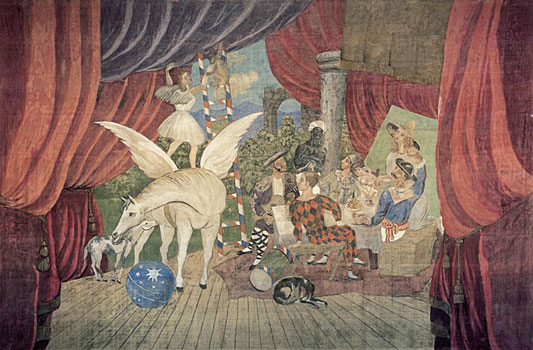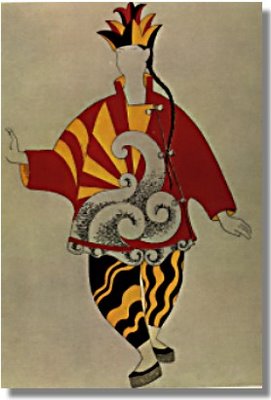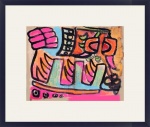The recent death of American dance titan Merce Cunningham was, for me, not a time to mourn but to celebrate a legacy born in great part out of his early collaborations with avant-garde composer John Cage and artist Robert Rauschenberg.
In celebration of his 90th birthday this April, […]
The recent death of American dance titan Merce Cunningham was, for me, not a time to mourn but to celebrate a legacy born in great part out of his early collaborations with avant-garde composer John Cage and artist Robert Rauschenberg.
In celebration of his 90th birthday this April, Merce Cunningham premiered his latest work ‘Almost Ninety.’The stage of the BAM Opera house was transformed into a futuristic, pulsating space with a set, designed by renowned architect Benedetta Tagliabue, that housed Led Zeppelin’s instrumentalist John Paul Jones and the indie-rock band Sonic Youth. The sold-out house, and long standing ovation at the end of the performance, were in stark contrast to the sixties and seventies when Cunningham’s audiences were sparse and often fled performances that some likened to ’watching laundry in spin cycle.’
My first introduction to a performance by Merce Cunningham and his company was in the early sixties in New Delhi, India. The audience had no idea what to make of a bicycle, draped in garlands of marigolds, that descended on to the stage from the rafters, or the weird electronic sounds composer John Cage was coaxing out of something akin to a sponge being rubbed on a piano. The audience, inured to more conventional dance flowing with the music and rhythm, got into the spirit when a Coca Cola bottle rolled down the aisle mid performance. The bottle was then rolled up and down the aisle by the audience who believed it was part of the show. At the post-performance dinner at the American ambassador’s residence John Cage confessed he was thrilled no end by the addition of the sound of the rolling bottle. It was in close collaborations with these artists that Cunningham threw conventional notions of dance out the window and forged a revolutionary vocabulary where movement, music, sets were created independently of each other.
This collaboration and crossover between art forms was by no means new. The man responsible for commissioning avant-garde artists to create costumes and designs for the stage was the great Russian impresario Sergei Diaghilev who settled in France with his dance company Ballet Russe de Monte Carlo. Leonide Massine’s 1917 ballet, ‘Parade’ for Ballet Russe was one of the first times avant-garde painters, composers and writers were asked to join forces on the creation of a ballet. Diaghilev commissioned Pablo Picasso to design the stage curtain and costumes, Erik Satie to compose the music and Jean Cocteau to write a script. Picasso’s design for the curtain was a figurative painting of a circus scene, but for the costumes he opted for a cubistic style. The premier performance at the Theatre du Chatelet in Paris horrified the public. The poet and art critic Apollinaire coined the term ‘Surrealism’ in the program notes forParade and wrote in the introduction “we find here for the first time this alliance of painting and dance, plastic and mimic art, which signals the advent of a more complete art”.
In 1973 Robert Joffrey, founder and director of the The Joffrey Ballet, resurrectedParade at the City Center in New York and gave many of us the opportunity to relish the sight of Picasso’s cubism leaping to life on stage. Another gift for New York audiences in 1979 was Joffrey’s resurrection of Nijinsky’s ‘L’Apres Midi d’un Faun’ (1912) with Russian painter and designer Leon Bakst’s stunning backdrop recreated by Ruben Ter Arturian. One of Bakst’s more flamboyant costumes was for Stravinsky’s The Firebird for Ballet Russe which premiered at the Paris Opéra, now the Palais Garnier, in 1910. Years later in 1945 Marc Chagall, another Russian painter who had studied with Bakst, created the sets and costumes for a New York production of The Firebird. And in 1926 Joan Miro and Max Ernst, in collaboration with members of the Surrealist movement, were commissioned to create monumental sets for Diaghilev’s ballets.
Diaghilev and Ballet Russe’s most controversial ballet was ‘La Sacre du Printemps,’ The Rite of Spring, with music by Igor Stavinsky and choreography by legendary Russian dancer Vaslav Nijinsky. The backdrop and costumes were designed by Russian painter and archaeologist Nicholas Roerich. When it had it’s first of only seven performances on May 29, 1913 the audience was in an uproar over Stravinsky’s discordant score and the jerky stomping movements of Nijinsky’s choreography. They stormed out of the theatre.
“When the booing and catcalls began, Stravinsky left the hall in a rage and went backstage, where he spent the rest of the performance holding onto Nijinsky’s coattails while the choreographer stood on a chair shouting numbers (in Russian) to the dancers, to try to keep them in time.”
–Wendy Thompson from the London Symphony Orchestra’s Bluffer’s Guide toThe Rite of Spring.
It was again Robert Joffrey who resurrected the ballet in 1987 with invaluable input by dance historian and choreographer Millicent Hodson and her husband Kenneth Archer, an art historian. For 15 years the couple meticulously researched the original production, piecing the ballet together from sketches, paintings, Roerich’s original costume designs, photographs, reviews and guidance from Nijinsky’s assistant. It was one of the most stunning dance highlights of my life.
“[The Rite of Spring] is an astonishing ballet, no less so today than in 1913. Nijinsky’s genius as a choreographer bursts forth here in the originality of his vision, the depth of his musicality and the grand sense of inevitability that reigns over the whole. Inspired by Roerich, a specialist in the primitive iconography of pagan Russia, Nijinsky created a movement style that would embody both the logic and the frenzy of Stravinsky’s music.” Laura Shapiro Newsweek,November 16, 1987.
In 1935 Martha Graham, an icon of American modern dance, used stage decor for the first time when she commissioned sculptor and designer Isamu Noguchi to create a set for her solo Frontier. Their collaboration was legendary and continued for three decades. He created sets for some of her most memorable works which included Night Journey, Clytemnestra and Appalachian Spring, with music composed by Aaron Copland. My special memories of Graham’s performances were when I first saw her perform in India in 1955; saw her last performance on stage in 1970 when she danced at City Center in New York in Cortege of Eagles at the age of 76; and a production of Appalachian Spring made memorable by Copland conducting the orchestra, and another legendary Russian dancer Rudolf Nureyev, somewhat out of his milieu, dancing the role of the revivalist preacher.
Out of Graham’s company were born innovators like Merce Cunningham and Paul Taylor who went on to stake their own fame in the contemporary American dance scene. While he was studying dance at Juilliard, the Martha Graham School and the Metropolitan Opera Ballet School, Paul Taylor worked as an assistant to Jasper Johns and Robert Rauschenberg, who were dressing windows for Tiffany’s at the time. He drew these artists and Ellsworth Kelly, Alex Katz, Santo Loquasto and Jennifer Tipton among others into collaborating with him on his dances. Outstanding among Rauschenberg’s creations for Taylor were the costumes for the witty Three Epitaphs (1955) where faceless dancers loped about like rag dolls, covered from head to toe in black body stockings speckled with shards of mirrors. And Taylor, like Cunningham and Diaghilev, in his early days sent bewildered audiences fleeing the theatre. Rauschenberg’s own constructions created from found objects bewildered viewers as well. In his May 14, 2008 obituary of Rauschenberg art critic Michael Kimmelman wrote in The New York Times:
“Mr. Rauschenberg, who knew that not everybody found it easy to grasp the open-endedness of his work, once described to the writer Calvin Tomkins an encounter with a woman who had reacted skeptically to “Monogram” (1955-59) and “Bed” in his 1963 retrospective at the Jewish Museum, one of the events that secured Mr. Rauschenberg’s reputation: “To her, all my decisions seemed absolutely arbitrary — as though I could just as well have selected anything at all — and therefore there was no meaning, and that made it ugly.
“So I told her that if I were to describe the way she was dressed, it might sound very much like what she’d been saying. For instance, she had feathers on her head. And she had this enamel brooch with a picture of ‘The Blue Boy’ on it pinned to her breast. And around her neck she had on what she would call mink but what could also be described as the skin of a dead animal. Well, at first she was a little offended by this, I think, but then later she came back and said she was beginning to understand.”
Both Diaghilev and Cunningham when asked in their time if they were upset at audiences fleeing their performances said they were, on the contrary, thrilled by the strong reaction. Could Diaghilev have imagined the world would be celebrating the centenary of the creation of the Ballet Russe in 2009?
The weekend I attended 90 year old Merce Cunningham’s latest work, I viewed an exhibition at the Gagosian gallery in Chelsea of Picasso’s works created in the last decade of his life. The paintings and drawings in Picasso: Mosqueteros were awash with a freedom and exuberance I had never experienced before in Picasso’s work. These brilliant provocateurs, in the tenth decade of their lives, exited with a final bang.
© Sukanya Rahman 2010 (originally published in Art Insider)
Copy Right
All Rights Reserved ©Sukanya Rahman 2011
Categories











